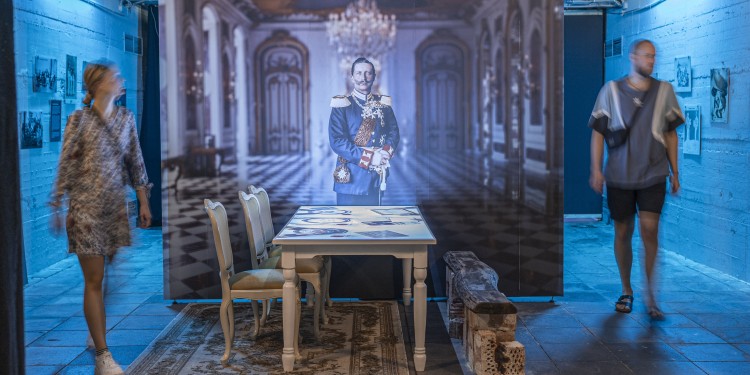
The man WWU is named after
January 2021 saw the start of a project entitled “Zur Sache WWU” (WWU = Westfälische Wilhelms-Universität), in which the University of Münster has been taking a critical look at the man who gave the University its name – Wilhelm II, the last German Kaiser (Emperor). What has happened in the past 24 months? Who was involved in the project? And why was such a critical examination necessary? The following article provides information on the most important aspects and developments, as well as on the background.
Starting point
There are often discussions about the names of streets, squares and monuments, especially when the person they are named after is now seen in a different light – because, for example, social and political attitudes have changed or because historical sources call for a reassessment. The names of universities are also the subject of such debates about name-changes. The University of Münster – the Westfälische Wilhelms-Universität, to give it its proper name – was named after Wilhelm II, during whose reign the “Royal Academy” in Münster was elevated to the status of a university.
As the last German Kaiser (Emperor) is still a controversial figure a century after his abdication – both as a person and as regards his rule – the Senate and the Rectorate of the University decided to set up an exchange of views among experts, members of the University and the public at large. In January 2021 the project entitled “Zur Sache WWU” got underway, since which time it has been coordinating the debate on how Wilhelm II should be viewed today.
It was all preceded by a resolution passed in the Senate in 2018 to draw up “a concept for a historically responsible way for the University of Münster (WWU) to view Wilhelm II”. The guiding principle was “to promote a critical public debate on his person”. At the time, a working group set up by the Senate, and headed by Prof. Olaf Blaschke, had established “that Wilhelm II was highly militaristic and nationalistic, anti-Slavic and almost obsessively antisemitic”. In addition, said the group, his role in German colonialism and its crimes needed to be discussed.
On the other hand, says the report, the last German Kaiser also promoted science and scholarship – to which the elevation of the Münster Academy to the status of a university in 1902 bears testimony. The intention behind the proposal to name the University after Wilhelm II was not to honour the Kaiser as someone to emulate, but rather as a founder and benefactor and as the ‘father of the nation’.
How the project proceeded
The core of the project is a critical historical study of Wilhelm II. To this end, the team examined sources stored in archives – for example, correspondence, newspaper articles and minutes of meetings. The aim has been to use these documents to retrace the history of the University’s name as far as possible and to place it in its historical context. The project team also had the task of looking at other debates on names and monuments. A nine-strong Academic Advisory Board – composed of experts from both within and outside the University – has been supporting the work and, as its name suggests, offering advice.
Formats of the debate
An important component of “Zur Sache WWU” involves incorporating the public and having discussions with a variety of target groups such as students and interested citizens. For this purpose, the project team drew up numerous formats for communication and for events – for example, a short film for the event welcoming freshers to the University, a radio programme produced in cooperation with the University’s Department of History and Radio Q, as well as three panel discussions. In the summer of this year, there was also an exhibition staged in the pedestrian subway between Schlossplatz and the lecture building. Students from the Münster School of Design showed an experimental artistic way of looking at the man who gave the University its name. Working together with the Verein für Geschichte und Altertumskunde Westfalens (Society for the History and Archaeology of Westphalia), Villa ten Hompel and the LWL Media Centre, the project team also organised public guided tours by bicycle relating to the Prussian history of the University and of the City of Münster.
Media response
Right from the start, many local and national media took an interest in the project. The media response is documented on the project’s homepage. The WDR5 and Deutschlandfunk radio stations were among those who covered the project, as did the prestigious national newspapers Frankfurter Allgemeine Zeitung and Süddeutsche Zeitung, which reported on the debate and the methods being used. The local media – for example, the Westfälische Nachrichten newspaper and Radio Antenne Münster – regularly feature updates on the process.
The future
The University of Münster is expected to decide on how to deal with Wilhelm II in 2023. The formal step is that the Senate, having decided on the basic principles, also takes the decision on the University’s name. The Rectorate, on the other hand, is first and foremost responsible for all other questions relating to how to handle the name of Wilhelm. Both bodies will correspondingly come to an agreement with each other. If necessary, the University will seek to have discussions with the Ministry of Science and Education of North Rhine-Westphalia if there is a statutory stipulation for the Ministry to be involved.
Author: Kathrin Kottke
This article first appeared in the University newspaper wissen|leben No. 8, 21 December 2022.
